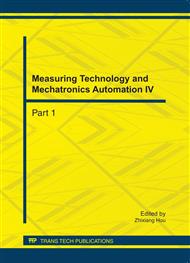p.1085
p.1089
p.1093
p.1097
p.1101
p.1105
p.1109
p.1114
p.1121
The Fault Diagnosis of Automotive Airbag Assembly Process Based on Self-Organizing Feature Mapping Network SOM
Abstract:
Automotive airbag assembly process is complex and nonlinear, and one of its characteristics is that the accuracy of making the threshold comparison for fault diagnosis using field multi-sensor measured value is not high,. In this article, adopt self-organizing feature mapping network SOM to realize the fault diagnosis of automotive airbag assembly process, constitute the field function of SOM through wavelet functions, form sub-excitatory neuron to update weights, avoid SOM local optimum, so improve the accuracy of fault diagnosis of automotive airbag assembly process.
Info:
Periodical:
Pages:
1101-1104
Citation:
Online since:
October 2011
Authors:
Price:
Сopyright:
© 2012 Trans Tech Publications Ltd. All Rights Reserved
Share:
Citation:


